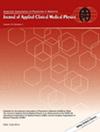Monte Carlo modeling of radiation dose from radiation therapy with superficial x-rays
Abstract
Introduction
Superficial x-rays (50–100 kVp) are used for treating non-melanoma skin cancer and intraoperative radiation therapy (IORT). At these energies, the photoelectric effect significantly increases absorbed dose to bone compared to soft tissue.
Methods
We used EGSnrc MC simulations to investigate bone dose enhancement during radiotherapy with the Sensus SRT-100 machine. Simulated beams were validated against laboratory measurements and compared to a commercial treatment planning system (SmART-ATP). Transmission simulations indirectly predicted bone dosage. Simulated beams were utilized as a mock treatment plan from a human cone-beam computed tomography (CBCT) image.
Results
EGSnrc accurately modeled the Sensus SRT-100 beams (100, 70, and 50 kVp) with a root mean square error (RMSE) of percentage depth dose ratios between Monte Carlo predictions and lab measurements of 1.66, 0.47, and 0.99, respectively. PDDs from simulations of a water phantom with bone slabs showed peak doses at water–bone interfaces relative to surface doses. At 0.3 cm depth bone slab, doses reached 410%, 490%, and 510% for 50, 70, and 100 kVp, respectively. At 1.5 cm depth, doses were 140%, 215%, and 270%. At 2.5 cm depth, peak doses were 74%, 130%, and 170% for 50, 70, and 100 kVp, respectively. A simulated treatment plan (4 Gy surface dose) using a CBCT of a human head predicted the dose to the skull to be around 20, 19, and 15 Gy for the 100, 70, and 50 kVp beams, respectively.
Conclusions
The study demonstrated EGSnrc's efficiency in conjunction with SmART-ATP for treatment planning. MC simulations effectively quantified bone dose enhancement during superficial x-ray radiotherapy, highlighting its importance in treatment planning and dose calculations. Clinicians should consider measuring bone depth prior to treatment to avoid excessive bone dose.

 求助内容:
求助内容: 应助结果提醒方式:
应助结果提醒方式:


